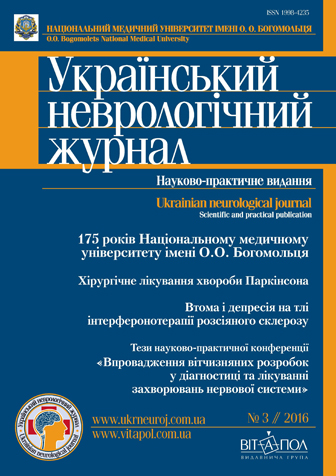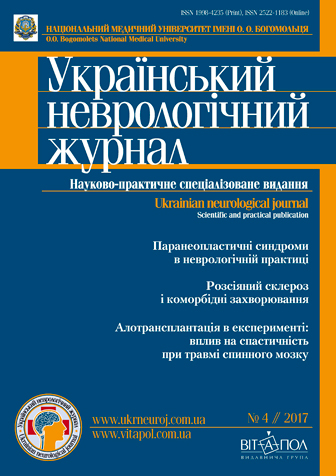- Issues
- About the Journal
- News
- Cooperation
- Contact Info
Issue. Articles
¹3(40) // 2016

1. Original researches
|
Notice: Undefined index: picture in /home/vitapol/ukrneuroj.vitapol.com.ua/en/svizhij_nomer.php on line 74 Notice: Undefined index: pict in /home/vitapol/ukrneuroj.vitapol.com.ua/en/svizhij_nomer.php on line 75 The investigation of enteroviruses genom in the blood serum of patients with acute strokeN. G. Andryushkova1, N. S. Turchina1, L. V. Dolinchuk1, V. A. Ponyatovskyy1, V. V. Melnik1, V. P. Shyrobokov1, L. N. Trepet21 O. O. Bogomolets National Medical University, Kyiv |
|---|
Methods and subjects. The blood serum of 72 patients with acute stroke and a control group of 30 patients with diseases of nonvascular origin diseases was examined to identify the enterovirus genom . Detection of enterovirus RNA was performed by PCR using the reverse transcription. Viruses were isolated on HeLa and HEp-2cell lines.
Results. The enterovirus genom was detected by PCR in 17 of the 72 samples of tested serum in research group (23.6 ± 5.0 %). Only one serum was PCR-positive on enteroviruses (3.3 ± 3.2 %) in the control group. Cytopathogenic agents were isolated in HEp-2 and HeLa cell lines from 11 PCR-positive samples of blood serum from the experimental group of patients. No viruses were isolated from the remaining PCR-positive and PCR-negative sera.
Conclusions. The presence of enteroviruses in the blood of patients with acute stroke suggests etiopathogenetical link between them. The introduction of PCR to detect enteroviral agents in patients with acute stroke complements existing methods of diagnosis. The knowledge extension of acute stroke development pathogenic processes and evidence of possible enteroviruses causes of atherosclerotic changes allows to improve present diagnostic methods, their application in treatment and prevention.
Keywords: enteroviruses, Coxsackie B virus, acute cerebrovascular accident, polymerase chain reaction.
Notice: Undefined variable: lang_long in /home/vitapol/ukrneuroj.vitapol.com.ua/en/svizhij_nomer.php on line 188
2. Original researches
|
Notice: Undefined index: picture in /home/vitapol/ukrneuroj.vitapol.com.ua/en/svizhij_nomer.php on line 74 Notice: Undefined index: pict in /home/vitapol/ukrneuroj.vitapol.com.ua/en/svizhij_nomer.php on line 75 Cognitive evoked potential Ð300 in conditions of chronic cerebral ischemiaÀ. V. DemchenkoZaporizhzhia State Medical University |
|---|
Methods and subjects. 263 patients with DE of the ², ²², and ²²² stages (average age — 55.30 ± 7.62 years) against the background of cerebral tissues and arterial hypertension were examined. Clinico-neuropsychological, laboratory, ultrasound, neurovisual and neurophysiological methods of investigation wre used.
Results. There were detected slight (40.68 %) and mild (49.05 %) CI in the clinical presentation of the patients with DE. Only 10.27 % of people did not demonstrate any CI. While DE stage progressing a significant prolongation of latent period (LP) N2 with the prevailing majority of leads (exluding Ñ3 andÐ3) and LP Ð300 can be observed. The excess of age values LP N2 and P300 was determined among the dominant majority of the patients with DE: 93.92 % and 64.64 % correspondingly. Probable differences in a duration of LP N2 (ð = 0.0001) and LP Ð300 (ð = 0.0003) using Kruskal-Wallis test were established among the patients with slight CI and with the maintained cognitive functions according to the neuropsychological testing results. According to the results of the neurophysiological investigation it was revealed a positive correlation of patients age, LP N2 (r = 0.25; p < 0.0001) and LP Ð300 (r = 0.33; p < 0.0001). The same connection was revealed of DE stage, LP N2 (r = 0.25; p < 0.0001) and LP Ð300 (r = 0.31; p < 0.0001), and of the thickness of common carotids intima media complex, LP N2 (r = 0.19; p = 0.002) and LP Ð300 (r = 0.21; p = 0.001). Also, there were revealed negative correlation of MOCA scale grade and LP N2 (r = –0.27; p < 0.0001) and LP Ð300 (r = –0.32; p < 0.0001). The probable prolongation of the average LP Ð300 was established among the patients with the combined nidal lesion of white substance and dilataion of liquor spaces and among the patients with postischemic cysts comparatively with this rate among the patients without structural changes.
Conclusions. The determination of CEP P300 is a modern objective non-invasive method of cognitive functions investigation and in combination with neuropsychological testing this method allows providing temporary diagnostics of cognitive impairments among the patients with chronic cerebral ischemia.
Keywords: chronic cerebral ischemia (discirculatory encephalopathy), cognitive evoked potential Ð300, cognitive impairments, neurovisualization changes.
Notice: Undefined variable: lang_long in /home/vitapol/ukrneuroj.vitapol.com.ua/en/svizhij_nomer.php on line 188
3. Original researches
|
Notice: Undefined index: picture in /home/vitapol/ukrneuroj.vitapol.com.ua/en/svizhij_nomer.php on line 74 Notice: Undefined index: pict in /home/vitapol/ukrneuroj.vitapol.com.ua/en/svizhij_nomer.php on line 75 The effectiveness of differential surgical treatment for severe forms of Parkinson’s diseaseK. R. Kostiuk, N. S. Vasyliv, V. L. LomadzeSI «Institute of Neurosurgery named after acad. A. P. Romodanov of NAMS of Ukraine», Kyiv |
|---|
Methods and subjects. 36 patients with PD aged from 37 to 77 years old (mean 58.6 ± 2.8 yrs.)were enrolled in the study, they were divided into 3 groups, depending on the type of surgery. 13 patients underwent stereotactic unilateral thalamotomy, 12 patients — stereotactic unilateral pallidotomy and 11 patients underwent bilateral deep brain stimulation of the subthalamic nucleus. Neurological and psychological status were assessed before and after the treatment by: UPDRS II, Hoehn and Yahr scale, Schwab and England scale, MMSE, Beck’s Depression Inventory, Hamilton Depression Rating Scale, Hamilton Anxiety Rating Scale and PDQ-39. Surgery was performed on CRW Radionics stereotactic system. Postoperative follow-up ranged from 1 to 7 years (mean 4.2 ± 0.8 yrs.).
Results. Regression of tremor, rigidity, bradykinesia and levodopa-induced dyskinesia were observed in most patients after the treatment. The best results in the motor disturbance correction were achieved in patients who underwent deep brain stimulation of the subthalamic nucleus. In this group UPDRS II score was improved by 74 % in «on period» and by 62 % in «off period». Surgical complications occurred in 4 (11.1 %) cases, which induced transient neurological deficit in 3 (8.3 %) patients which reduced within 3 months after surgery.
Conclusions. Stereotactic interventions are effective and safe method of surgical treatment of severe forms of PD. Ablative and neurostimulating interventions improve overall motor function, patient’s mobility and quality of life. Obtained data determine the introduction of differentiated approaches on surgical treatment for PD, based on clinical presentation of the disease, concomitant somatic pathology, psychiatric disturbances and patient’s age. Severity of psychoemotional disturbances in patients with PD depends on the duration of the disease and levodopa-therapy application. Stereotactic interventions do not provoke cognitive impairment and in some cases reduce the severity of depression and anxiety.
Keywords: Parkinson’s disease, stereotactic radiofrequency thalamotomy, pallidotomy, deep brain stimulation, levodopa induced-dyskinesia, motor fluctuations.
Notice: Undefined variable: lang_long in /home/vitapol/ukrneuroj.vitapol.com.ua/en/svizhij_nomer.php on line 188
4. Original researches
|
Notice: Undefined index: picture in /home/vitapol/ukrneuroj.vitapol.com.ua/en/svizhij_nomer.php on line 74 Notice: Undefined index: pict in /home/vitapol/ukrneuroj.vitapol.com.ua/en/svizhij_nomer.php on line 75 Effectiveness evaluation of the retrospective SPECT/MRI fusion in the diagnosis of brain gliomaS. S. Koval, S. S. Makeyev, T. G. NovikovaSI «Institute of Neurosurgery named after acad. A. P. Romodanov of NAMS of Ukraine», Kyiv |
|---|
Methods and subjects. 94 patients with verified brain glioma were subjected to consecutive MRI, SPECT with tumor seeking radiopharmaceuticals and retrospective SPECT/MRI fusion. The effectiveness of retrospective SPECT/MRI fusion in brain glioma diagnosis was evaluated by the criteria of sensitivity, specificity and accuracy. Also all cases were assessed according to the qualitative and quantitative criteria.
Results. The following types of brain glioma were identified: glioblastoma (WHO grade IV), 41 cases (44 %), sensitivity 97 % and accuracy 81 %; anaplastic glioma (WHO grade III — IV), 32 cases (34 %), sensitivity 74 % and accuracy 53 %; glioma (WHO grade I — II), 21 cases (22 %), specificity 90 % and accuracy 86 %.
Conclusions. Retrospective SPECT/MRI fusion is effective in the diagnosis of brain glioma.
Keywords: brain glioma, single photon emission computed tomography, magnetic resonance imaging, SPECT/MRI fusion.
Notice: Undefined variable: lang_long in /home/vitapol/ukrneuroj.vitapol.com.ua/en/svizhij_nomer.php on line 188
5. Original researches
|
Notice: Undefined index: picture in /home/vitapol/ukrneuroj.vitapol.com.ua/en/svizhij_nomer.php on line 74 Notice: Undefined index: pict in /home/vitapol/ukrneuroj.vitapol.com.ua/en/svizhij_nomer.php on line 75 Fatigue and depression in patients with multiple sclerosis treated with interferonT. A. Dovbonos, Yu. V. KhyzhniakO. O. Bogomolets National Medical University, Kyiv |
|---|
Methods and subjects. Thirty patients with multiple sclerosis were estimated to have symptoms of fatigue and/or depression, depicted after the beginning of interferon usage. Fatigue was scored by the Fatigue Severity Scale (FSS), and depression was assessed by The Beck Depression Inventory (BDI).
Results. The mean FSS score was 4.3 ± 0.23 and 5.7 ± 0.77 with duration of interferon-β treatment within 24 months and more than 24 months respectively (ð = 0.018). The fatigue and depression combination was found in 63.3 %. The mild, moderate and severe fatigue related to the mean depression score was 11.7 ± 1.7, 14.2 ± 2.3, 18.0 ± 1.7 respectively (p = 0.034). Depression was determined in 81.8 % of females and 52.6 % of mails with no significant difference in degree between the genders (ð > 0.05). Depression signs were always depicted in patients, who received the high dose of interferon-β, and its degree depended on EDSS level (ð < 0.01).
Conclusions. Frequent combination of fatigue and depression as side effects of interferon-β treatment was evaluated in patients with relapsing remitting multiple sclerosis. The interferon therapy duration of more than 2 years is linked with more severe degree of fatigue, but doesn’t correlate with depression. The results also showed the elevation of mean depression score with increasing of EDSS score. Depression was tended to be more frequent among females and in patients receiving high dose of interferon-β.
Keywords: multiple sclerosis, interferon-β, side effects, fatigue, depression.
Notice: Undefined variable: lang_long in /home/vitapol/ukrneuroj.vitapol.com.ua/en/svizhij_nomer.php on line 188
6. Original researches
|
Notice: Undefined index: picture in /home/vitapol/ukrneuroj.vitapol.com.ua/en/svizhij_nomer.php on line 74 Notice: Undefined index: pict in /home/vitapol/ukrneuroj.vitapol.com.ua/en/svizhij_nomer.php on line 75 Validation of national Ukrainian version of DN4 questionnaire for identification of neuropathic component of chronic low back painV. I. RomanenkoO. O. Bogomolets National Medical University, Kyiv |
|---|
Methods and subjects.103 patients with chronic low back pain and 30 healthy subjects were examined. Examination included clinical and neurological testing, based on which all patients were divided into 4 groups according to QTFCSD. Identification of neuropathic component of pain was made using DN4 questionnaire, which includes 7 items related to symptoms and 3 items associated with the neurological examination.
Results. ROC-analysis (receiver operating characteristics) was carried out and discriminant value of DN4 questionnaire were identified for 4 points out of 10 with sensitivity of 67.9 %, specificity — 94.0 % and Youden index of 0.62. At the lumbar level average score on the DN4 questionnaire in the group of patients was 2.81 ± 1.38; 27 (26.2 %) patients had a score ≥ 4 out of 10. In the most distal area of pain irradiation in the lower extremity the average score on the DN4 questionnaire was 4.85 ± 1.71; 65 (63.1 %) patients had a score ≥ 4 out of 10. The percentage of patients with a score ≥ 4 out of 10 according to DN4 questionnaire at the lumbar level was significantly higher (p < 0.05) in group IV compared to the other three groups. The average score on the DN4 questionnaire at the lumbar level was significantly higher in group IV 3.33 ± 1.56 compared to group I (of 2.26 ± 1.01).
Conclusions. This study validated national Ukrainian version of the DN4 questionnaire for identification of neuropathic component of low back pain. It has been shown that the use of national Ukrainian version of the DN4 questionnaire separately for the lumbar level and lower extremities allows to determine the presence of neuropathic component of pain even in atypical cases, where the neuropathic pain is not suspected, what enables to plan adequate mechanism-based pharmacotherapy.
Keywords: low back pain, DN4 questionnaire, neuropathic pain.
Notice: Undefined variable: lang_long in /home/vitapol/ukrneuroj.vitapol.com.ua/en/svizhij_nomer.php on line 188
7. Original researches
|
Notice: Undefined index: picture in /home/vitapol/ukrneuroj.vitapol.com.ua/en/svizhij_nomer.php on line 74 Notice: Undefined index: pict in /home/vitapol/ukrneuroj.vitapol.com.ua/en/svizhij_nomer.php on line 75 Myalgic syndrome associated with influenza BV. V. Gnatiyk, T. V. PokrovskaDanylo Halytsky Lviv National Medical University |
|---|
Methods and subjects. 24 children aged from 4 — 12 years affected with influenza were observed. The molecular-genetic method PCR, luminescence (fluorescence) microscopy, immunochromatographic analysis were used to verify the influenza diagnosis. The level of creatine phosphokinase was determined and the electromyographic research was carried out.
Results. Influenza B during the 2014 — 2015’s epidemic season in children characterized by a moderate course with a predominance of intoxication symptoms against the background of typical for influenza changes of laboratory parameters in peripheral blood. The feature in the course of influenza in children was the emergence of myalgic syndrome of severe intensity, localized in the calf muscle, which appeared on 3 — 5 days from the onset of a disease with a decrease of intoxication not being observed during the previous epidemics. Myalgias of calf muscles in the setting of influenza were recorded in children aged 4 — 12 years old.
Conclusions. Myalgia syndrome is the feature in the course of influenza B during the 2014 — 2015’s epidemic season. For the purpose of differential diagnosis with neurological complications it is advisable to determine the level of creatine phosphokinase in the blood. A direct correlation has been remarked of the creatine phosphokinase level in blood serum and intensity of myalgic syndrome.
Keywords: influenza B, children, myalgic syndrome, calf muscle, creatine phosphokinase.
Notice: Undefined variable: lang_long in /home/vitapol/ukrneuroj.vitapol.com.ua/en/svizhij_nomer.php on line 188
8. CASE FROM PRACTICE
|
Notice: Undefined index: picture in /home/vitapol/ukrneuroj.vitapol.com.ua/en/svizhij_nomer.php on line 74 Notice: Undefined index: pict in /home/vitapol/ukrneuroj.vitapol.com.ua/en/svizhij_nomer.php on line 75 Psychogenic movement disorders (clinical case)A. I. Baidauletova1, 2, O. A. Shavlovskaya31 Kazakh Medical University of Continuous Education, Almaty, Kazakhstan |
|---|
Keywords: psychogenic movement disorders, psychogenic dystonia, fixed dystonia, conversion disorder, somatoform disorder.
Notice: Undefined variable: lang_long in /home/vitapol/ukrneuroj.vitapol.com.ua/en/svizhij_nomer.php on line 188
9. Experimental researches
|
Notice: Undefined index: picture in /home/vitapol/ukrneuroj.vitapol.com.ua/en/svizhij_nomer.php on line 74 Notice: Undefined index: pict in /home/vitapol/ukrneuroj.vitapol.com.ua/en/svizhij_nomer.php on line 75 Effect of olfactory bulb tissue transplantation in the course of the regeneration process in spinal cord injury in experimentV. I. Tsymbaliuk1, V. V. Medvediev2, Yu.Yu. Senchyk3, N.Ya. Grydina1, N. G. Draguntsova1, S. M. Dychko1 |
|---|
Methods and subjects. Animals: albino male rats (5.5 months, 300 grams, inbred line, the original strain — Wistar); main experimental groups: 1 — spinal cord injury + immediate homotopical implantation of a fragment of the olfactory bulb tissue (n = 34), 2 — spinal cord injury only (n = 40). Model of injury — left-side spinal cord hemisection at Ò11 level; monitoring the ipsilateral hindlimb function indicator (IHL FI) — the Âasso — Âeattie — Âresnahan scale (BBB).
Results. TOBT does not change the distribution of IHL FI values in the experimental group, but distorts the dynamics of its changes: in the early period of trauma provides a reliable advantage of the IHL FI with a maximum at the 3rd week (3.7 ± 0.5 points BBB), followed by a significant gradual decrease to a 2.4 ± 0.6 points BBB (24th week). IHL FI values crossing with the control group was noted at the 8th week. This group is characterized by the biphasic dynamics of IHL FI increase throughout the experiment. Quick TOBT positive effect is probably associated with VEGF-dependent neuroprotective influence, the negative dynamics during the 2 — 6 months of the experiment — with verified degradation of graft and newly formed microvessels of perifocal zone.
Conclusions. TOBT causes a temporary, limited by the early period of traumatic process, positive effect on the efferent motor system recovery, evaluation of this type of neurotransplantation effectiveness requires taking into account the dynamics of the spasticity syndrome and chronic pain.
Keywords: spinal cord injury, transplantation of olfactory bulb tissue, motor function recovery, posttraumatic spasticity syndrome.
List of references:
1. Akimov G. A.,Odinak M. M. Differencial’naya of diagnostika nervnykh bolezney, 2001
2. Gnezdickiy V. V. Vyzvannye potencialy mozga in klinicheskoy praktike. — M.: MEDpress-inform, 2003. — 252 s.
3. Golubev V. L., Veyn A. M. Nevrologicheskie sindromy. — M.: MEDpress-inform, 2007.
4. Grinberg D.A, Aminoff M.Dzh, Saymon R. P. Klinicheskaya nevrologiya, 2004.
5. Shtul’man D. Levin O. S. Nevrologiya. Spravochnik of prakticheskogo vracha. — M.: Medpress, 2008.
6. Mumentaler of M. of Differencial’nyy of diagnoz in nevrologii
7. Nikolaev SG Workshop on Clinical electromyography. — Ivanovo : Ivanov. state. honey. Academy, 2003. — 264 p.
Notice: Undefined variable: lang_long in /home/vitapol/ukrneuroj.vitapol.com.ua/en/svizhij_nomer.php on line 188
Current Issue Highlights
¹4(45) // 2017

Paraneoplastic syndromes in neurological practice
E. G. Dubenko, L. I. Kovalenko
Analysis of comorbid diseases in patients with multiple sclerosis
Ò. ². Nehrych, Ê. Ì. Hychka
Comparative analysis of the rat’s paretic limb spasticity against the background of spinal cord injury, adult olfactory bulb and fetal cerebellum tissue allotransplantation
V. I. Tsymbaliuk 1, 2, V. V. Medvediev 2, Yu. Yu. Senchyk 3, N. G. Draguntsova 1
Log In
Notice: Undefined variable: err in /home/vitapol/ukrneuroj.vitapol.com.ua/blocks/news.php on line 50

